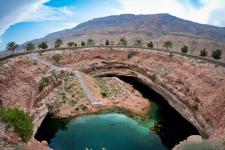
Sinkholes are defined as a depression or hole in the surface of the earth due to the erosion of the underlying ground layer. Such sinkholes develop over time with a diameter ranging between 1 – 600m. Sinkholes can form on both land masses and ocean ground surfaces. They can have both, natural and anthropogenic (human made) causes. Most natural sink holes are often caused by erosion which can either be physical or chemical. Physical erosion for example can be caused by the runoff of water eroding rock material on the other hand chemical erosion, sometimes called chemical weathering, can be caused by acidic liquids dissolving soluble rock material. Both of these phenomena lead to the creation of sub surface holes or cave – when these underlying caves collapse a sink hole is formed. Human made sink holes are often a result of underground development such as mining. More characteristics of sinkholes can be found in the next section.
Characteristics
- Natural sinkholes require specific geological conditions to form, this means their distribution is limited to karst regions
- The diameter and depth of sinkholes vary greatly
- Land based sinkholes can sometimes be filled with water
- The deepest natural sinkhole is located in
- The deepest sinkhole filled with water is located in the Czech Republic and is believed to extent down to 1200m below sea level – so far only 400 meters of the sink hole have been explored by humans
- Water based sinkholes are also called blue holes
- The deepest blue hole known to mankind is located in the South China Sea and has a depth of 300.89 meters.
Impacts/damage
Both, natural and human caused sink holes can pose a great risk to local communities. When sinkholes occur in urban areas they can result in the partial and complete collapse of over ground structures in damages to infrastructure, cause high economic losses, evacuation and displacement of residents and can in some rare cases lead to the loss of lives. When sinkholes occur in nature their impact is more limited to changes in the regional topography, change to local fauna and flora and change the course of sub-surface water ways.

The 2010 Guatemala sinkhole (Source: REUTERS/Daniel LeClair)
Emergency Action
If you are in a public area:
- Evacuate immediately
- Do not get too close to the sinkhole
- Call emergency services if the hole is large and a risk to others
- Raise awareness of other members of the public and ensure that others do not enter the area of and around the sinkhole
If you are in a residential area
- Evacuate immediately
- Under no circumstances enter your house again if structures are at risk of collapse
- Do not get too close to the sinkhole
- Call emergency services if the hole is large and a risk yourself or/and to others
- Raise awareness of neighbors and other residents which could be at risk
- Watch out for surface cracks and stay back
Mitigation
Sinkhole mitigation is mostly undertaken by regional and local governments. This can include continuous ground surveying using a range of techniques such as ground penetrating radar (GPR). More recently scientists have utilised space based radar information from satellites to indentify sinkholes. If you are interested in finding out more about this a number of studies can be found at the end of this text.
If you are a resident and you want to take actions for mitigation you can do the following:
- Check your home and property for:
- Cracks in the exterior and interior walls of your home
- Sloping and unevenness of the floors in your home
- Muddy or clouded water in your toilette, shower and tap
- Cracks (especially in circular shape) around your property
Research Papers investigating the use of space based sensors for sinkhole monitoring:
https://ieeexplore.ieee.org/abstract/document/7895138/
https://www.sciencedirect.com/science/article/pii/S0169555X15002305
